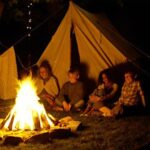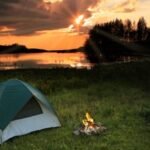A few weeks ago, we wrote a “Guide to Deciphering Camping Tent Jargon” that was aimed at new campers. It received a great response, making us realize there are quite a few people out there who are just dipping their toes into the world of camping. If you are still pondering what sleeping bag will let you sleep the best this summer, keep reading; the Guide to Camping Sleeping Bags will light your way.
A Mummy Sleeping Bag from Coleman
Shape
A sleeping bag’s shape is probably the most common question shoppers have: is a mummy, a rectangular, a semi-rectangular, or even a woman’s bag right for you?
A mummy bag has a tapered, mummy-like shape that gives you the least amount of air space between the bag and your body. This makes it the best bag for cold weather. Other perks include that mummies are the lightest weight because they have the least material. However, this shape bag tends to run slightly more expensive; also, restless sleeps may find the shape restrictions annoying.
Rectangular bags can be considered the opposite of the mummies. They provide the maximum amount of air space between your body and the bag, but that also means it takes much more body heat to heat up the bag. This makes rectangular bags bad for cold weather. They are also heavy and big, which makes them a poor choice for backpacking.
The semi-rectangular bags are a compromise between the last two, and you may find this to be the best in price-point and warmth. They are roomier than the mummy, but more restrictive and, therefore, warmer than a rectangular. They are a lighter weight than the rectangular bags, but still bulkier than a mummy.
If you are a woman, you may want to get a woman-specific bag. These are tailored to a woman’s body: narrower at the shoulders and wider at the hips. When you are trying to minimize air space inside the bag, these specifications do make a difference.
This Semi-Rectangular Bag has a comfort range of 15° to 30°, making it a 3-season bag.
Season
Like camping tents, sleeping bags are designed for specific temperature ranges, which makes them season specific. The temperatures are the most accurate when you are sleeping with standard camping gear: a sleeping pad for ground insulation and a tent or tarp to block you from cold wind and add insulation.
There are four such temperature ranges. Bags made for use in “extreme” conditions- think polar weather – have ratings for -10° and lower. Cold weather bags have a range of -10° to 10°. 3-season bags are 10° to 35°. Summer bags are 35° and higher.
While these are called “comfort ranges,” they are obviously not the actual temperature ranges in which you will feel comfortable. Rather, they are the coldest temperatures in which you feel comfortable. Still, it is typically recommended that you add 10° to the minimum temperature in a sleeping bag’s range. So, if you are buying a 3-season bag, you should plan to never be sleeping outside in weather colder than 45°.
With its rectangular shape and cotton shell, this sleeping bag is best for warm weather or indoor sleeping.
Shell
It is likely that a bag’s shell will play a smaller role in the buying process, but it is still important. Sleeping bags are typically made from one of three materials: nylon, cotton, or polyester. If you are planning to camp regularly or even semi-frequently, buy a nylon bag. These are lightweight and durable, so they are easy to pack and carry and will stand up to the wear and tear of camping. Polyester and cotton bags are less expensive but also less durable. Polyester bags have a much shorter lifespan than nylon bags, whereas cotton bags are only recommended for summer temperatures.
Fill
There are three main materials used to fill sleeping bags: synthetic insulation, down, and cotton. Like with the bag’s shell, cotton fill is typically only recommended if you plan to camp in the summer or will be sleeping on the floor indoors; it dries extremely slowly and is not especially warm. Down is a great filler, but is more expensive than other sleeping bags. If you can afford the price tag, however, go for it; you will be buying the lightest, yet warmest fill that is also the most compressible and longest lasting. In other words, it is great for camping enthusiasts. For a cheaper bag that performs nearly as well as the down bags, though, the very common synthetic filled sleeping bags are great.



